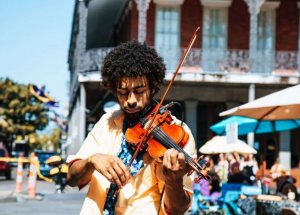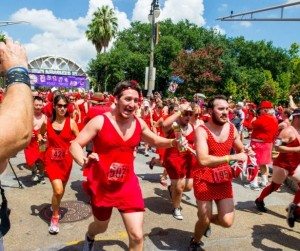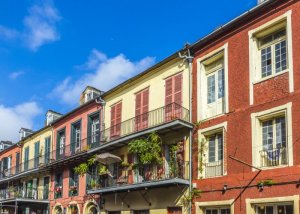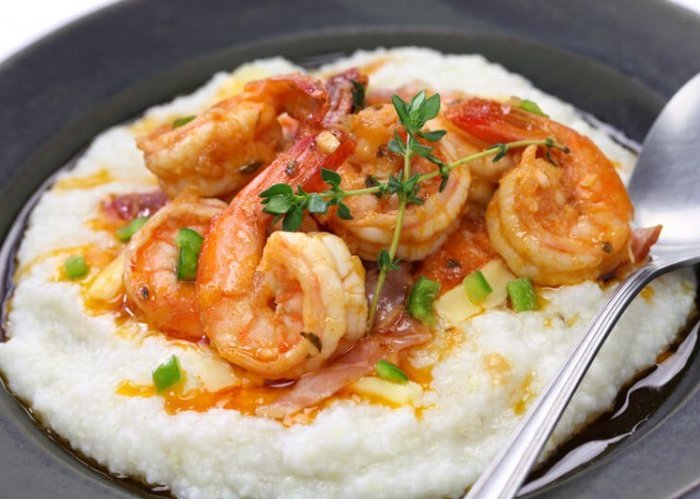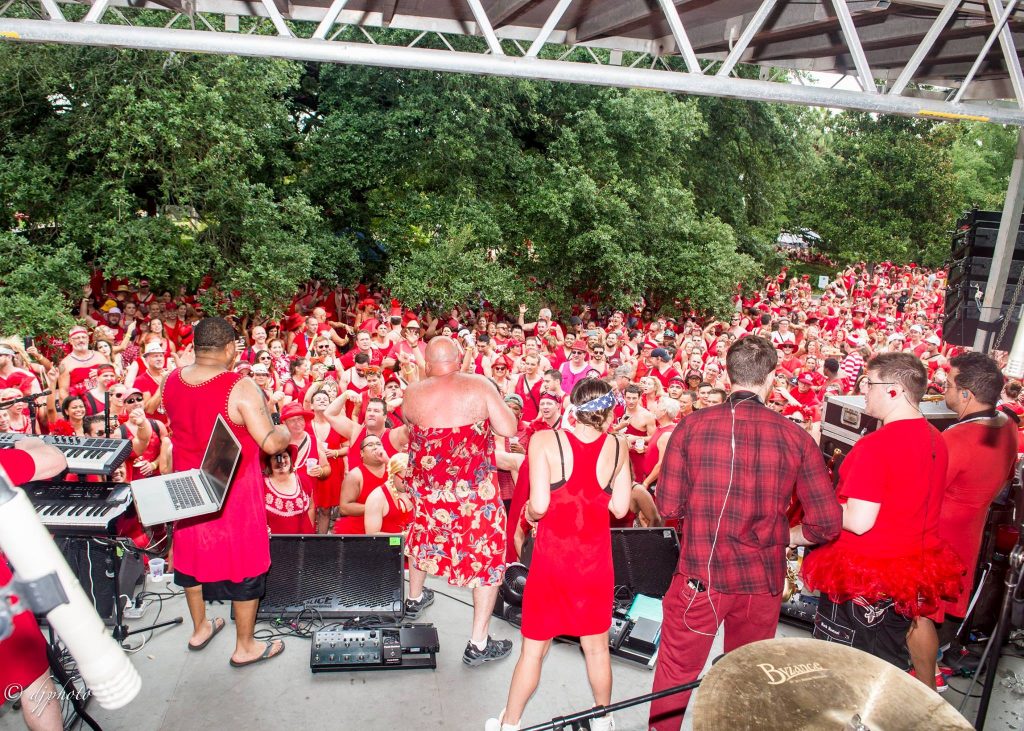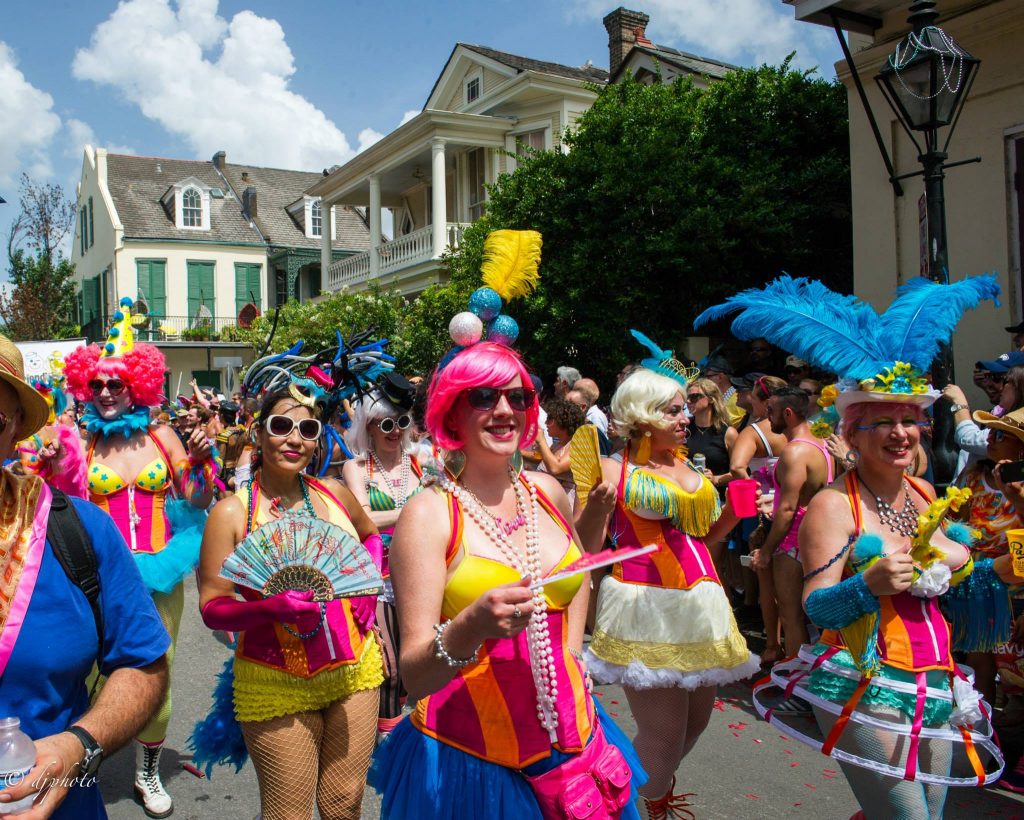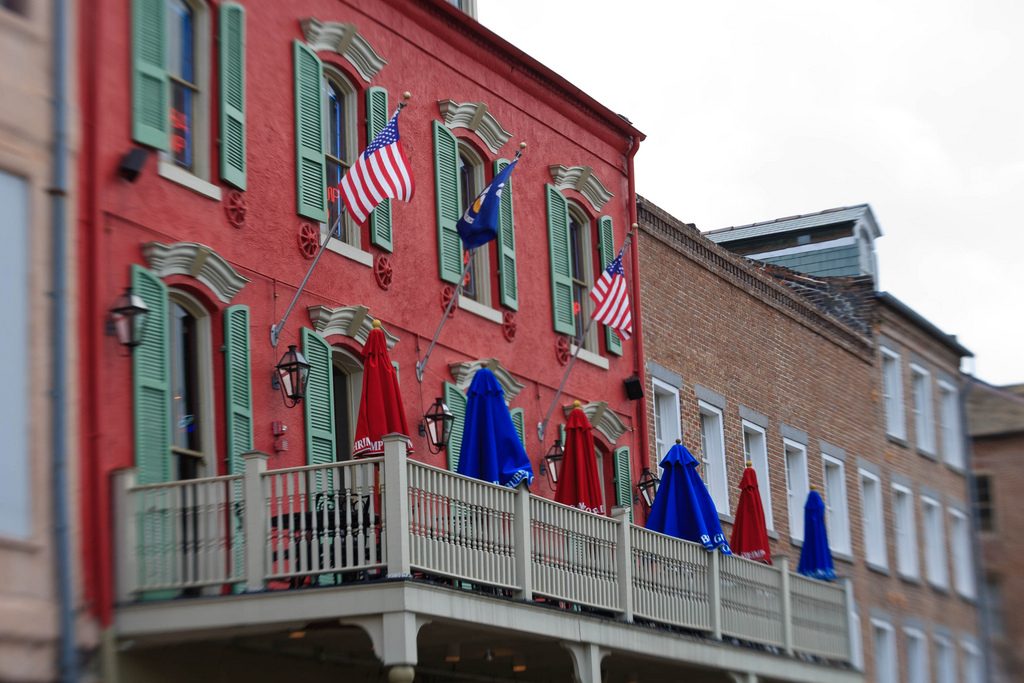What to Do in July in New Orleans
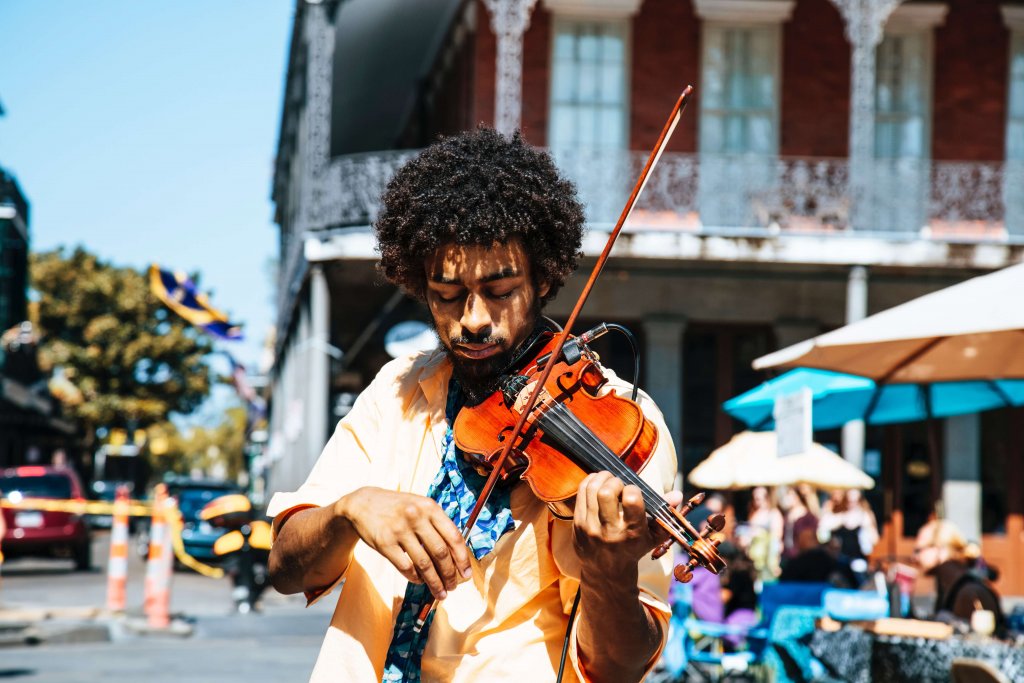
Photo by William Recinos on Unsplash
Summer in New Orleans is HOT, but we’ve got a slate of festivals that will cool you off and keep you entertained.
Independence Day
Friday, July 4, 2025
New Orleans celebrates July 4th like anywhere else in America, but with a flavor all her own. There will be fireworks above the Mississippi River and much partying as usual. As part of the annual “Go 4th on the River” celebration, the “Dueling Barges” will again put on a spectacular fireworks show set to patriotic music.
There are plenty of great spots to watch the display, but a French Quarter balcony is one of the most desired viewing spots in the city. You can grab excellent vantage points on the Riverfront, and in the Marigny and Bywater too. The Woldenberg Park on the shoreline of the Mississippi River is also an excellent spot to throw a picnic while you wait for the fireworks, as well as another waterfront park, Crescent Park. Coolers and chairs are welcome.
ESSENCE Festival of Culture
Thursday-Sunday, July 3-6, 2025
There’s a lot to love about the ESSENCE Festival of Culture, beyond the fact that it is the largest annual African American culture and music event in the world. It’s one of the finest gatherings of musicians in a city that is well-known for throwing together excellent gatherings of musicians.
Beyond the concerts held each night of the fest at the Superdome, its free daytime experiences at the Convention Center include motivational seminars, beauty and style presentations, celebrity interviews, cooking demonstrations with top chefs, and lots more.
Expect a stellar music lineup of major headliners and the best of the local talent. The festival’s theme is “Made Like This”. Notable performers include Boyz II Men, Jill Scott, Maxwell, Master P, GloRilla, The Isley Brothers, Nas, and Summer Walker. A tribute to Quincy Jones will be performed by Jermaine Dupri. This year, the festival is celebrating its 31st anniversary.
The traditional Sunday Gospel Celebration at the Convention Center will feature the greatest gospel hits, and ESSENCE After Dark, a series of late-night jam sessions, comedy shows, underground performances, live podcast recordings, and more, is returning once again to the Superdome.
Don’t wait! Get your tickets online. You can also download the festival’s app. And please remember that all events held at the Convention Center during the day are free and open to all (registration is required though for anyone over 18).
Bastille Day Fête
Friday, July 11, 2025
The Alliance Française de La Nouvelle-Orléans holds its annual celebration, which is an open-air evening of French music, culture, food, and community. There will be live music, a costume contest, kid-friendly activities, and French-centric food and wine. You can get tickets in advance on the event’s website.
San Fermin in Nueva Orleans (Running of the Bulls)
Friday-Sunday, July 11-13, 2025
Plenty of people know that Encierro de Pamplona is a major event in the Spanish tourism calendar, but not as many folks realize New Orleans hosts its own bull run. Except here, the “bulls” are roller derby girls, dressed in the traditional colors of Spain’s bull run and wearing horned helmets, who whack the participants — dressed all in white with red scarves and handkerchiefs — with wiffle bats.
This year, the Saturday, July 12, 2025, run takes place at the Gallier Hall, starting at 6:30 a.m. The annual El Txupinazo party takes place on Friday, July 11, 2025, from 6 to 9 p.m. This is a ticketed event and 18+ only.
Check out the schedule on the event’s website for the annual opening and closing parties happening that weekend. You can also get your tickets online.
Tales of the Cocktail
Sunday-Friday, July 20-25, 2025
Some of the world’s most famous cocktails were invented in this city: the Sazerac, Brandy Milk Punch, and Ramos Gin Fizz, to name a few. Having a drink in New Orleans isn’t just fun — it’s also a celebration of our unique history.
Still, New Orleans can’t just let a cultural touchstone be without holding a festival, and thus, Tales of the Cocktail, a celebration of mixed drinks in all of their vast diversity. Every year, the party draws in thousands of bar owners, distillers, mixologists, authors, tastemakers, and enthusiasts who are interested in networking, sharing knowledge, showing off their skills, learning, and, well, drinking.
This six-day event is filled with seminars, workshops, tastings, book signings, bartender contests, networking, and much more. The Tales’ 2025 theme is “Evolve,” and the festival’s signature annual blowout, the “best of” Spirited Awards, will be held on Thursday, July 24, 2025, followed by the always-popular after-party.
During the festival, Tales of the Cocktail hosts dozens of events. Please note that tickets for events are sold individually, so you can build your own itinerary. The prix fixe tasting menus and food-pairing dinners are especially popular, and the tours and cocktail-themed parties also tend to sell out quickly, so we highly recommend getting your tickets as early as you can.
Coming to New Orleans in July?
Check out our guide to where to stay in the French Quarter, and be sure to check out our resource for French Quarter Hotels. Also, consider booking a guided tour of St. Louis Cemetery No. 1 to experience the hauntingly beautiful past of New Orleans.
For easy, informative sightseeing, we recommend the City Sightseeing New Orleans city tour on the open-top, double-decker bus. It runs every 30 minutes through the Garden District, French Quarter, and CBD. You can hop on and off anytime!
Happy July!
Related Articles
JOIN THE NEWSLETTER!
Suit Up for the Red Dress Run in New Orleans
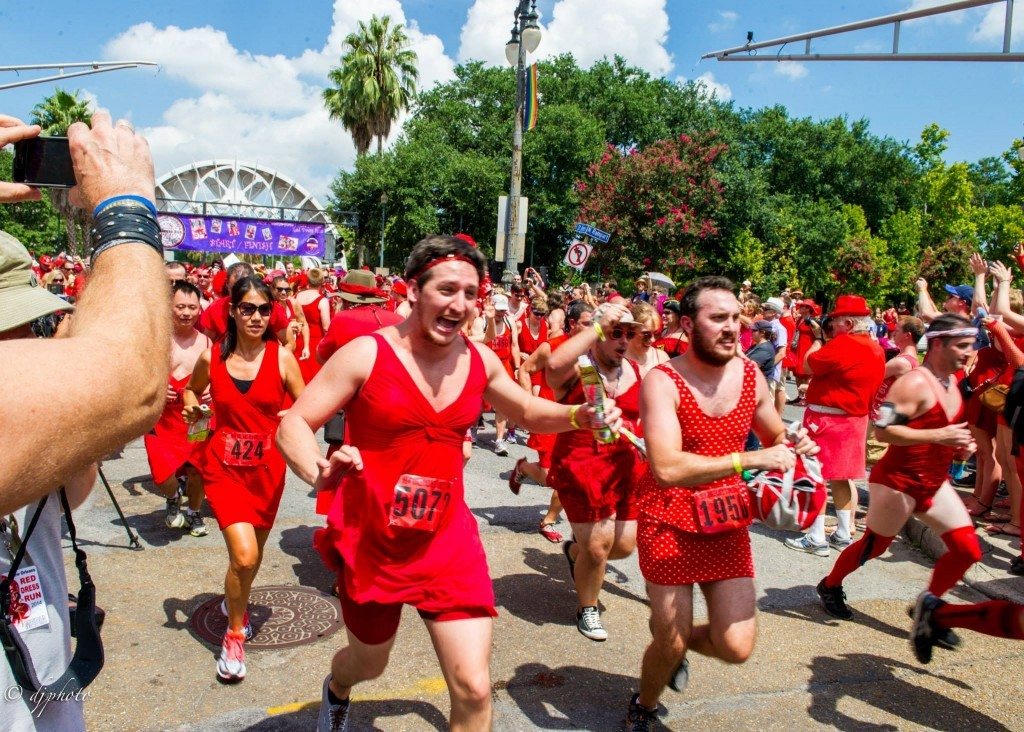
All photos are courtesy of David Fary
You’d be tempted to call thousands of sprinting women and men kitted out like a Chris de Burgh single (“Lady in Red”) a drag race, but no. It’s a dress run. On the second Saturday of August — this year, that’s August 9, 2025 — the New Orleans Hash House Harriers (NOH3) are at it once again, hosting the annual New Orleans Red Dress Run.
The Event Details
Still going strong after more than two decades, the run draws in thousands of men and women aged 21 and older, who take to the French Quarter to showcase the color red in all of its glory (and let’s be honest, sometimes lack thereof).
This year, the run once again assembles in Crescent Park around 9 a.m., with beer flowing. Late registration goes on until the start of the run (10 a.m.), which tends to finish in a crimson scrum of sweat and live music. Admission for this event is $89 after June 1. Pre-registration is available online with a $4 processing fee. Day-of registration is cash only.
The two-mile run route is a closely guarded secret, but expect runners to jog/stumble/sprint through the Bywater and Marigny neighborhoods, eventually making it into the French Quarter and back to the Crescent Park. Once the run is over at 11:30 a.m., the all-you-can-eat lunch is served. The whole affair is over by 4 p.m.
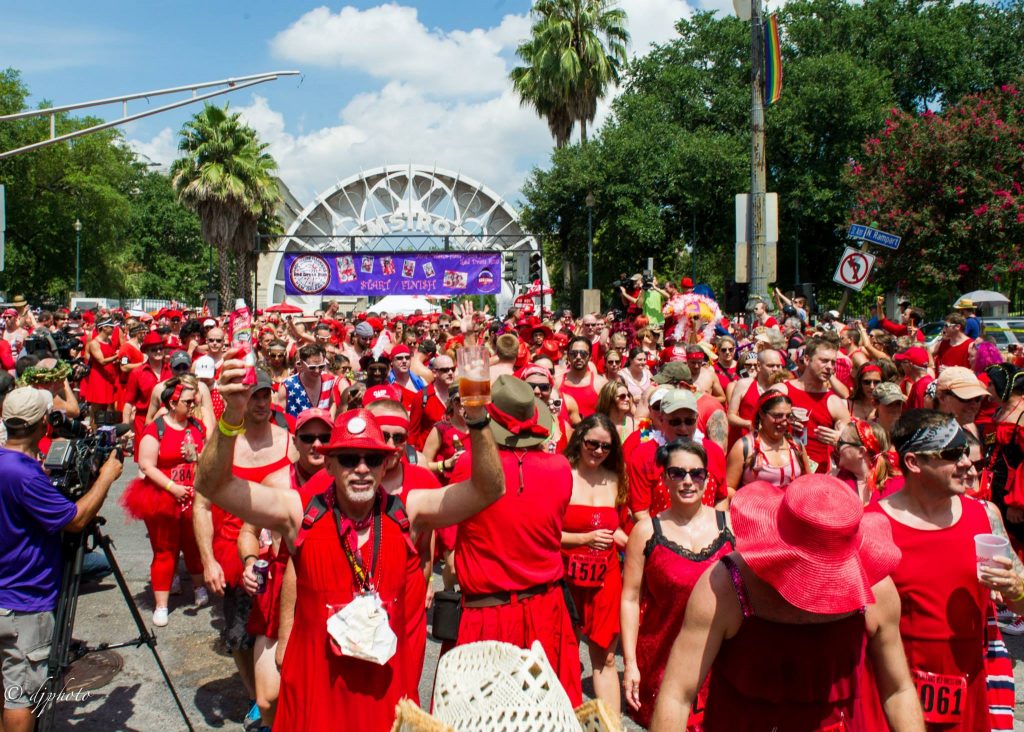
Tips for the Red Dress Run
Here are some pro tips we’ve collected over the years from repeat participants. New Orleans heat in August is no joke, so we hope you heed the advice to stay safe, hydrated, and have fun.
No one wants to be dragged down with a handbag, so consider investing in a fanny pack or a Ziploc bag “wallet” for phone cards and cash. Another option is to wear a dress that is tight up top so you can hold your phone, cash, card, and ID securely in the breast area (yes, this goes for guys too).
Just assume that it will be seriously hot, and a breathable pair of underwear is a good investment. We also recommend headbands and sweatbands that are good to wipe off moisture that’s your own and from others who are tipsy and bumping into you.
Remember, this is a long party with food, beer, and music. Avoid rough sequins under the arms, because arm abrasion will rain on your parade really fast. If you are unsure, dance around the house with some bold arm movements to see if you’ve got the right stuff on top.
Some more run etiquette: Tie your shoes. The last thing you want is someone stepping on your laces and you, or them, falling. If you are going slowly, no worries, although a koozie might be a good idea as your drink will get hot, quickly.
About the Red Dress Run
The entire affair owes its existence to the remarkable efforts of the local chapter of Hash House Harriers, a club dedicated to running and drinking (many Hashers would flip those priorities). The club — a “Drinking Club with a Running Problem” — is international, and you can find a Hash/Run event in almost every country in the world. Proceeds from the event benefit different charities.
The calendar of runs is on the NOH3 website, and membership is open to anyone over 21. All you need to do is show up.
Just remember, it takes more than putting on a red dress and tying off a few in the Quarter to be a part of this historic event. Don’t be a red dress rip-off — register to enjoy unlimited beer, food, and music.
As mentioned above, the run route is secret, so follow the event on Facebook. For spectators looking to watch the action, the race “track” has always traversed Bourbon and Royal Street in the past, with a handful of beer stops along the route.
Need to find a hotel? To stay close to all the action, book a historic boutique hotel in the French Quarter at FrenchQuarter.com/hotels today!
Related Articles
JOIN THE NEWSLETTER!
What to Do in New Orleans This August
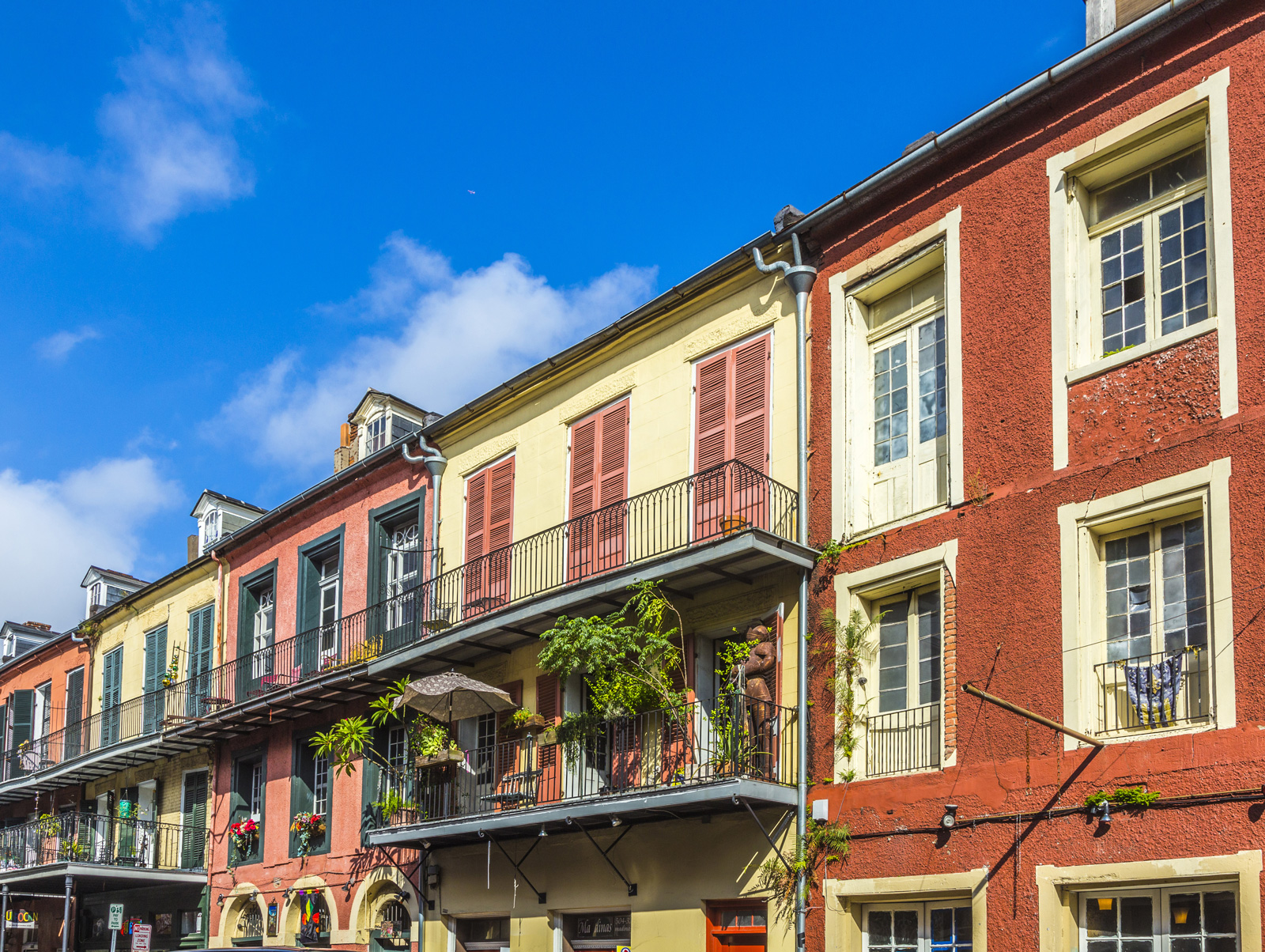
August in New Orleans brings the promise of a series of festivals, parties and holidays — official and unofficial — that seem to pack every weekend. Truth be told, the month’s calendar gets so busy, we have to wonder why spring gets to carry the label of “festival season.”
As the days reach their maximum length and the nights get sultry and sweaty, remember that the best means of keeping yourself close to the action in the French Quarter is booking a hotel that’s within walking distance of all the action. Speaking of — here are some of our favorite summer events popping off during August.
COOLinary
Friday, August 1 – Sunday, August 31, 2025
The premise of COOLinary is simple: Dozens of area restaurants offer prix fixe menus to customers at a discount. Sometimes, a significant discount — as low as $28 or less for two-course lunches and $58 or less for three-course dinners and brunches. This is a New Orleans event that’s as popular with the locals as tourists, and many city residents take advantage of Coolinary to engage in a bit of gastronomic splurging.
Interested? Check out the COOLinary website and see what restaurants are participating (and for which meals; some spots, for example, only offer a COOLinary menu during lunch). You don’t have to do anything else but show up and get fed; usually, the Coolinary menu is included as a special insert or addition to the regular menu.
Museum Month
Friday, August 1 – Sunday, August 31, 2025
If you’re in town this August, be sure to take advantage of the Museum Month deal. During the month of August, museum members have the opportunity to visit all participating institutions, FREE OF CHARGE, using their current membership throughout the month of August.
You must be a member of a local museum to take advantage of this deal. This is a great opportunity to explore on a budget. In the past, participating museums in (and near) the French Quarter include the Beauregard-Keyes House, Audubon Insectarium, Contemporary Arts Center, The National WWII Museum, Old Ursuline Convent Museum, New Orleans Jazz Museum, New Orleans Pharmacy Museum, and Ogden Museum of Southern Art. This year, the list of participating museums has a total of 28.
Fidelity Bank White Linen Night
Saturday, August 2, 2025
Back in the days before air conditioning, New Orleanians kept cool and looked fresh in the face of August swelter by wearing light-colored linen clothing. Back in the days before White Linen Night, local art galleries felt the pinch of the August tourism slowdown.
In order to combat said slowdown, and to showcase local summer fashion, White Linen Night was created. Art galleries and restaurants on the 300-600 blocks of Julia Street in the Warehouse District throw their doors open for a night of wine, art perusing, dining, and more wine — plus modeling of, naturally, the latest in white linen fashion.
Satchmo SummerFest
Saturday-Sunday, August 2-3, 2025
An initiative from the folks at French Quarter Festivals, Satchmo Summer Fest is a celebration of the city’s most famous musical son (Louis Armstrong, nicknamed “Satchmo”) and New Orleans music in general. As New Orleans festivals go, this one is pretty beloved — it’s family-friendly, kicks off within the French Quarter with a popular parade, the lineup is truly local, and it’s free. More than almost any other festival we mention, this one feels like a New Orleans street party (again, for families), and it definitely should not be missed if you’re in town.
Red Dress Run
Saturday, August 9, 2025
Probably the last thing any sane human being wants to do in the midst of a New Orleans August is run, but then again, the folks involved with the New Orleans Hash House Harriers (NOH3) have always been a little crazy. The Red Dress Run is your chance to see a bunch of locals of all genders don red frocks and go careening through the city on a madcap 2-3 mile course.
Said route is kept secret until the day of the run, but racers always pass through the Quarter. Come out, wear crimson, have a beer (many of the runners will be joining in with you), and enjoy the show.
Dirty Linen Night
Saturday, August 9, 2025
The more rebellious sibling to White Linen Night, Dirty Linen is a similar gallery evening, but in this case, the galleries are located in the Quarter along 300-1100 blocks of Royal Street, and the vibe is a little more counterculture. Peruse food trucks, galleries, and bars, help yourself to the wine the gallery owners brought along with them, and enjoy an unbridled celebration of the creativity of the city.
Southern Decadence
Friday, August 29 – Monday, September 1, 2025
New Orleans’ largest LGBTQ+ event is a citywide party that celebrates the huge impact the local gay and lesbian community has on the city at large. Almost a week’s worth of partying will kick off within the Quarter, spreading across New Orleans as more and more guests swoop into town for several days of… well, as the title says, decadence.
Coming to New Orleans in August?
Check out our guide to where to stay in the French Quarter, and be sure to check out our resource for French Quarter Hotels. Also, consider booking a guided tour of St. Louis Cemetery No. 1 to experience the hauntingly beautiful past of New Orleans.
For easy, informative sightseeing, we recommend the City Sightseeing New Orleans city tour on the open-top, double-decker bus. It runs every 30 minutes through the Garden District, French Quarter, and CBD. You can hop on and off anytime!
Happy August!
Related Articles
JOIN THE NEWSLETTER!
COOLinary: What’s on the Menu in August
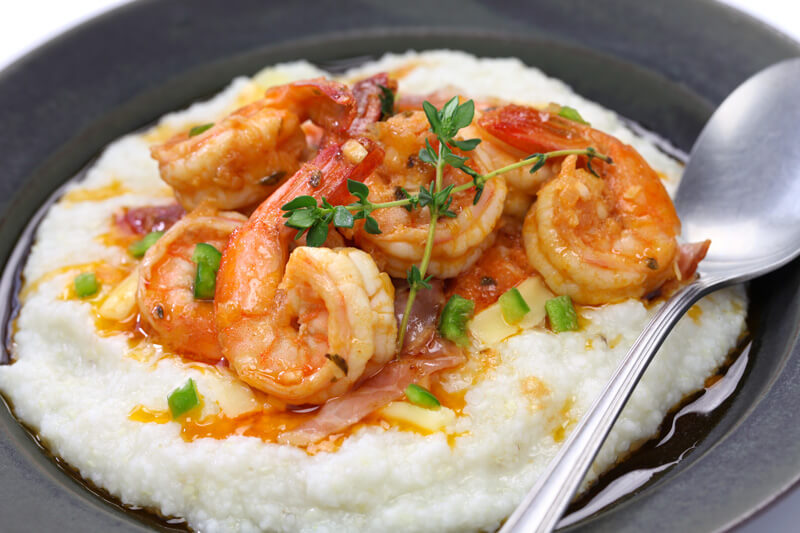
Photo courtesy of COOLinary New Orleans
There’s no better time to dine at an award-winning restaurant during your visit to New Orleans (or while you play tourist in your own city) than in August. Not only do you get to experience cuisine that is an integral part of the New Orleans heritage, but you’ll be doing so at a discount. This is your chance to try out that new restaurant or revisit the old favorite!
COOLinary was conceived by New Orleans & Company (formerly the New Orleans Convention and Visitors Bureau) as a promotion to lure diners to local restaurants in the slower summer months — the month of August especially — during which restaurants all over the city offer discounted dining deals. It’s the only dining program of this caliber that offers deals this time of year, though you can enjoy similar perks during the citywide holiday Reveillon promotion in December and the Restaurant Week New Orleans (June 16-22, 2025).
Ever since COOLinary came into existence 20 years ago, it has kept growing in size and popularity. In the past few years, the number of participating restaurants has grown to reach 100, and kept going, some with multiple locations across the city. The restaurants that are taking part in this annual summer promotion are spread all over the city, including the Marigny, CBD, Uptown, and the French Quarter, and run the gamut from the iconic to the smaller, casual ones.
This year, the list of 83 restaurants includes the famous Antoine’s, Arnaud’s, Brennan’s, Cafe Degas, Commander’s Palace, and Galatoire’s. The Uptown’s Brigtsen’s and Treme’s Gabrielle both joined this enviable roster in the past and are this year’s participants as well.
The menus and the list of the participating restaurants are typically announced in June, but, basically, expect $28 or less for two-course lunches and $58 or less for three-course dinners and brunches.
Once posted, the restaurant list is searchable by location, with each listing accompanied by a sample menu that includes the price, and you can also make a reservation right then and there.
Many of the restaurants that participate in these promos are located in the French Quarter or downtown, within walking distance from many historic hotels. So, book a hotel, make a reservation, and get out there and enjoy the culinary gems New Orleans has to offer!
Related Articles
JOIN THE NEWSLETTER!
More Winnin’ at Dirty Linen
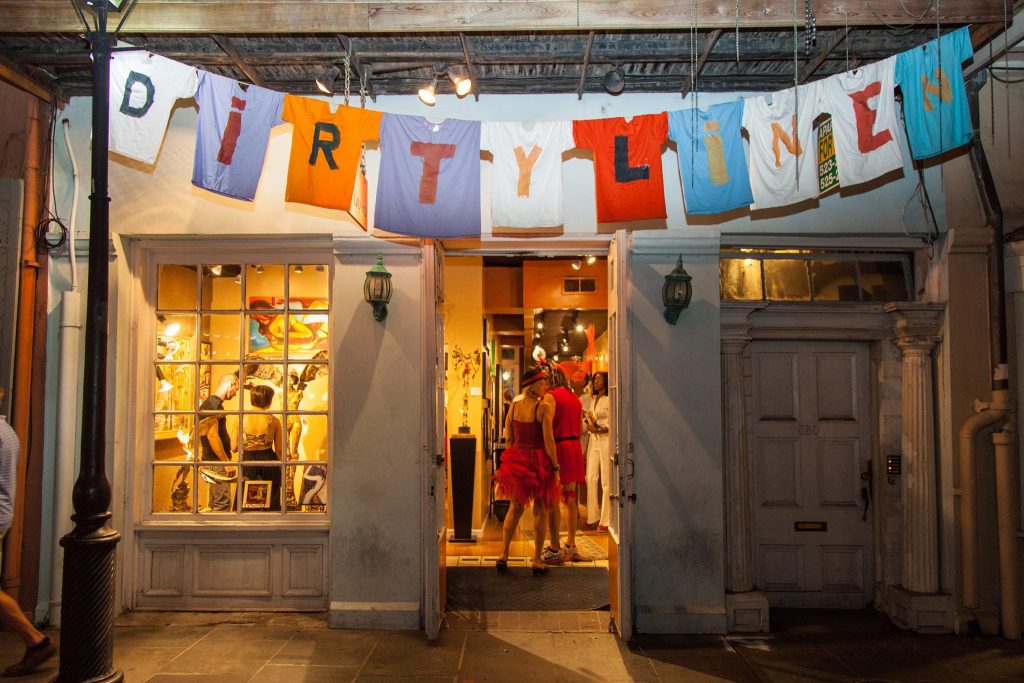
Image courtesy of Dirty Linen Night on Facebook
Every year, Dirty Linen Night invites New Orleanians and tourists alike to celebrate the city’s French Quarter art galleries and boutiques. The event follows the White Linen Night, usually held on the Saturday before. The Dirty Linen Night was originally conceived not to compete but as a way to encourage people to visit Royal Street and support local businesses.
This year’s event, the 22nd annual Dirty Linen Night, lasts from 6 to 9 p.m. (officially — the event generates its own momentum and tends to run a little late) and will be held on Saturday, August 9, 2025. The festivities will feature dozens of participating galleries and businesses, multiple blocks of pedestrian-friendly celebrations, buskers, delicious food, drink specials, and plenty of good times.
The bulk of the action will occur between the 300 and 1100 blocks of Royal Street. Dirty Linen is free and open to the public. You can also buy raffle tickets online to win artwork and gifts.
And, oh, make sure to wear unwashed white linen from the previous week — Dirty Linen is a continuation of the White Linen party, albeit one that is a little more raucous than the Julia Street event. We’re kidding, by the way — while you’re encouraged to wear last week’s linen, any kind of flowy, comfortable summer clothes will do.
The Galleries and Businesses
It’s impossible to describe every participating gallery and shop in a short article (here’s the full list), but here are some of the highlights. French Quarter art galleries regularly provide discounts on Dirty Linen Night.
Gallery Rinard
611 Royal St.
Owned and operated by the artist Matt Rinard, this gallery features the work of many of the area’s renowned painters and sculptors, with a focus on whimsy and humor rather than what we think of as classic Southern art.
Rodrigue Studios
730 Royal St.
George Rodrigue (1944-2013), a native son of South Louisiana, was best known as the creator of the “Blue Dog,” perhaps the most recognizable symbol of Louisiana contemporary art. The dog, with its soulful yellow eyes, was first painted in 1984 for Bayou, a selection of Louisiana ghost stories released in conjunction with the 1984 World’s Fair, held in New Orleans.
Rodrigue decided to paint a version of the Cajun loup garou, or werewolf, and in so doing created the ghostly visage of the Blue Dog. At once approachable, mysterious and riotously colorful, the Blue Dog would go on to become, in the eyes of the public, a stand-in for Cajun culture and Louisiana as a whole and the vehicle for Rodrigue’s considerable commercial success.
Frank Relle Photography
910 Royal St.
One of the city’s most famous photographers, Frank Relle has made a career out of his love of New Orleans architecture, history, and light — or lack thereof, in the last case. Confused? Relle is best known for taking shots of New Orleans homes, buildings and street scenes late at night, using long exposures to create a singularly eerie (yet also oddly comforting, and always beautiful) micro genre of fine art photography.
Scene by Rhys
708 Toulouse St.
Located in a courtyard, this gallery is a fine base for local artist and all-around character Emile Rhys. A supremely talented artist, Rhys is best known for her fine art ink and pen drawings of the city’s local musicians. Her work, which synthesizes two great elements of New Orleans creativity — the sonic world of music and the frenetic energy of her visual art — is unique and singularly worthy of souvenir consideration.
Where to Eat
Many of New Orleans’ classic restaurants like Antoine’s, Galatoire’s, Mr. B’s Bistro, and Arnaud’s are within walking distance of the participating galleries. Here are some other spots outside of the pantheon of classic Creole institutions that you would want to sample.
Bayona
430 Dauphine St.
Chef Susan Spicer’s restaurant features daily specials and a creative mix of foods influenced by cuisine from around the globe. Try the veal sweetbreads with sherry-mustard butter.
Bennachin
1212 Royal St.
You might have tried Bennachin’s legendary mburu akara (black-eyed pea fritters and tomato stew on French bread) and jama jama ni makondo (sautéed spinach, fried plantains and coconut rice) at Jazz Fest, where the longtime spot for African fare has a perennial presence. The food tastes even better when consumed in the cozy, colorful French Quarter destination. Bonus: A BYOB policy makes Bennachin an excellent place to affordably wine and dine.
Cafe Amelie
900 Royal St.
The elegant courtyard and delicious modern Louisiana fare at Cafe Amelie are all part of a package that is equally as romantic and heart-stopping.
Napoleon House
500 Chartres St.
Although this weathered brick building was offered as a refuge to Napoleon Bonaparte by its owner, New Orleans mayor Nicholas Girod, the exiled emperor died before taking advantage of the gesture. However, the name stuck. Today, it’s a unique place to taste New Orleans cuisine in a setting that feels rich with history. Try the restaurant’s specialty, the muffuletta, with its signature cocktail, Pimm’s Cup.
Sylvain
625 Chartres St.
Located in a historic French Quarter carriage house, this eatery has classic options like a hamburger or a chicken sandwich alongside elevated Louisiana-centric fare.
Need a hotel? To stay close to all the action, book a historic boutique hotel in the French Quarter at FrenchQuarter.com/hotels today!
Related Articles
JOIN THE NEWSLETTER!
Celebrate Labor Day Weekend in the French Quarter
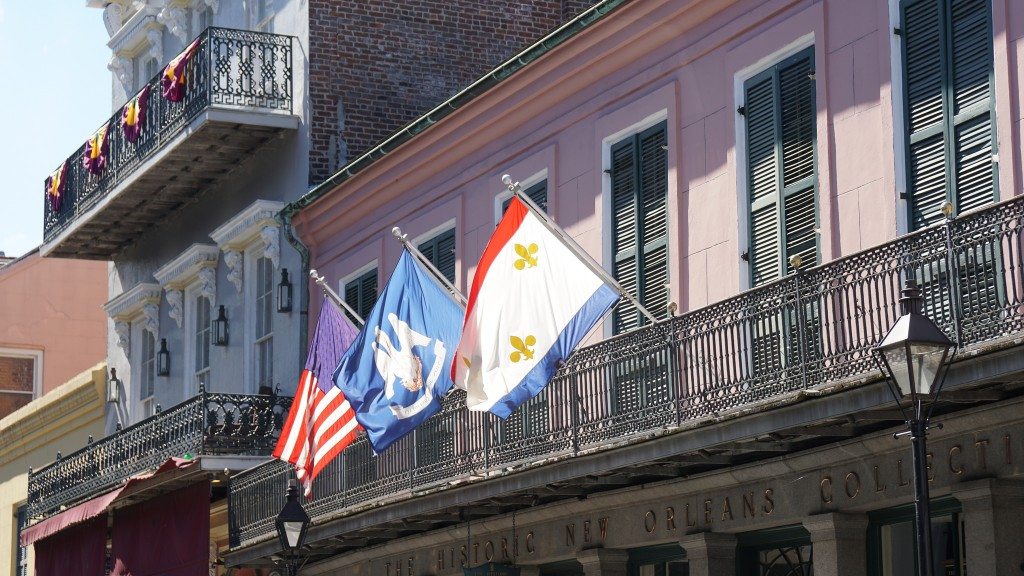
Photo by Miguel Discart on Flickr
Say goodbye to summer and ease yourself into fall by celebrating Labor Day (Monday, September 1, 2025) in New Orleans. Americans do travel a lot for this long weekend ending on the first Monday of September, and New Orleans is a top Labor Day destination.
There are great reasons for the city’s popularity, and don’t let the still-summery temps of early September deter you — the Labor Day weekend in New Orleans will deliver, and then some. Here are some suggestions on how to get the most out of your stay in the French Quarter, starting with the immensely popular Southern Decadence festival.
Southern Decadence
This massive three-day festival celebrates LGBTQ+ culture and attracts participants from all over the world. Southern Decadence started as a humble going-away party but is now considered the fifth largest event in the city after Mardi Gras, Jazz Fest, Essence Festival, and the French Quarter Festival.
Southern Decadence will be held from Friday, August 29, through Monday, September 1, 2025. It kicks off and closes with dance parties. There will be lots of block parties and dance parties in between. This year’s theme is “Etched in Stone, Timeless and Decadent.” The official colors are black, gold, white/silver, and purple.
The festival’s annual hub, Bourbon Pub Parade, will be open till 5 a.m. on Friday and Saturday, and 3 a.m. on Sunday. Just like in previous years, it will serve as the epicenter of the annual Bourbon Street Extravaganza, a free show/block party happening on Saturday at the corner of Bourbon and St. Ann Streets. The annual Southern Decadence Grand Marshal Parade on Sunday will also end up there, stretching loosely one block over to its ending point at Bourbon and Dumaine Streets.
A lot of events are free, and you can buy passes online to access the events that do charge an entrance fee and may sell out. The VIP Weekend Pass covers all events; the Weekend Pass includes all events held Friday through Sunday.
The Oz dance club and Cafe Lafitte in Exile, both on Bourbon Street, will also host DJ’d shows and dance parties that weekend. Although not part of the Bourbon Street stretch, the 24/7 Good Friends bar at 740 Dauphine Street in the French Quarter also receives a fair share of the festival partygoers each year. Another popular destination is the 24/7 Phoenix Bar (941 Elysian Fields Ave.), located in the Marigny within a short walking distance from the French Quarter.
Musical Highlights
Your best bet would be to just head out to Frenchmen Street on any given evening and explore, and there’s something always going on at the iconic Tipitina’s Uptown. The Labor Day weekend’s musical offerings are usually excellent. Let the WWOZ Livewire Music Calendar guide you.
Eating and Drinking
For happy hour, various French Quarter bars are offering lots of great deals, including The Bombay Club. For more ideas, check out our guide to the best happy hours in the French Quarter. As for eating, the French Quarter is your oyster, and then some. Check out our dining guides and listings to reserve a perfect spot.
If you’re planning a stay in New Orleans during the Labor Day weekend, be sure to check out our resource for French Quarter Hotels.
Eat, drink, dance, stay cool, and happy Labor Day!
Related Articles
JOIN THE NEWSLETTER!
The Inside Scoop on Southern Decadence in the French Quarter
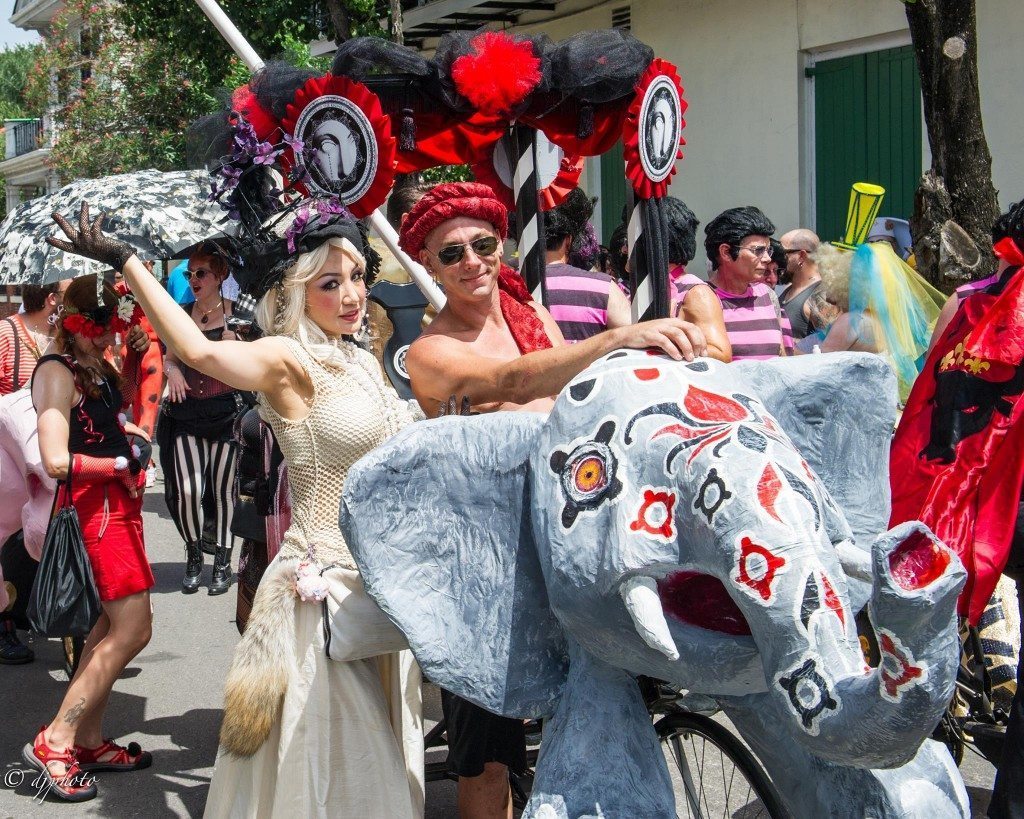
Photo by David Fary
Born in the early 70s as a going-away party, Southern Decadence has evolved into a massive and immensely popular three-day festival that celebrates LGBTQ+ culture and attracts participants from all over the world. It’s traditionally celebrated over the Labor Day weekend and is considered the fifth largest event in New Orleans after Mardi Gras, Jazz Fest, Essence Festival, and the French Quarter Festival.
This year’s Southern Decadence falls on Friday, August 29, through Monday September 1, 2025. The 2025 Grand Marshals Monique Michaels-Alexander, Bill Hincks, Willie Mackie, and ChiChi Rodriquez announced that this year’s theme is “Etched in Stone, Timeless and Decadent.” The official colors are black, gold, white/silver, and purple.
Just like every year, most activities will be centered in and around the French Quarter, with lots of block parties and dance parties at bars and clubs on Bourbon Street. The hub of the festival is again Bourbon Pub/Parade, with two rocking floors and an expansive balcony. The Pub will be open late nightly, especially on Friday and Saturday (till 5 a.m.)

Photo by David Fary
The Pub will be hosting numerous events throughout the festival, including a kick-off and closing parties. It will again serve as an epicenter of the annual Bourbon Street Extravaganza, a free show/block party happening at the corner of Bourbon and St. Ann Streets.
The annual Southern Decadence Grand Marshal Parade on Sunday will start at the Golden Lantern Bar (1239 Royal St.) at 2 p.m.

Photo by David Fary
Several French Quarter bars and clubs will also host the festival crowds that weekend. Oz dance club and Lafitte’s, both on Bourbon St., will be hopping as they do every year. Oz has DJ’d shows every night and fills up during Southern Decadence. Lafitte’s, a 24/7 French Quarter mainstay since the 1950s, has generous happy hour deals and a wraparound balcony.
Although not part of the Bourbon Street stretch, the Good Friends bar at 740 Dauphine St. in the French Quarter also receives a fair share of the festival partygoers. The downstairs will be open for 24 hours Wednesday through Sunday.
Although a lot of events are confined to the French Quarter, the festival generally spills into quite a few bars and clubs in the Marigny and the Bywater. The Friendly Bar at 2301 Chartres St. is a quiet neighborhood bar with a pool table, solid jukebox, and well-priced drinks. Big Daddy’s Bar (2513 Royal St.) also has a pool table, a jukebox, and a neighborhood vibe. These two bars, plus Pepp’s Pub right next door to Big Daddy’s Bar (it replaced Cutter’s), are great for a quiet after-party conversation.
Another popular destination is the 24/7 Phoenix Bar (941 Elysian Fields Ave.), located in the Marigny within a short walking distance from the French Quarter.

Photo by David Fary
Are you planning to spend some time in New Orleans during Southern Decadence? To stay close to all the action, book a historic boutique hotel in the French Quarter at FrenchQuarter.com/hotels today!
Related Articles
JOIN THE NEWSLETTER!
Things to Do in the French Quarter This September
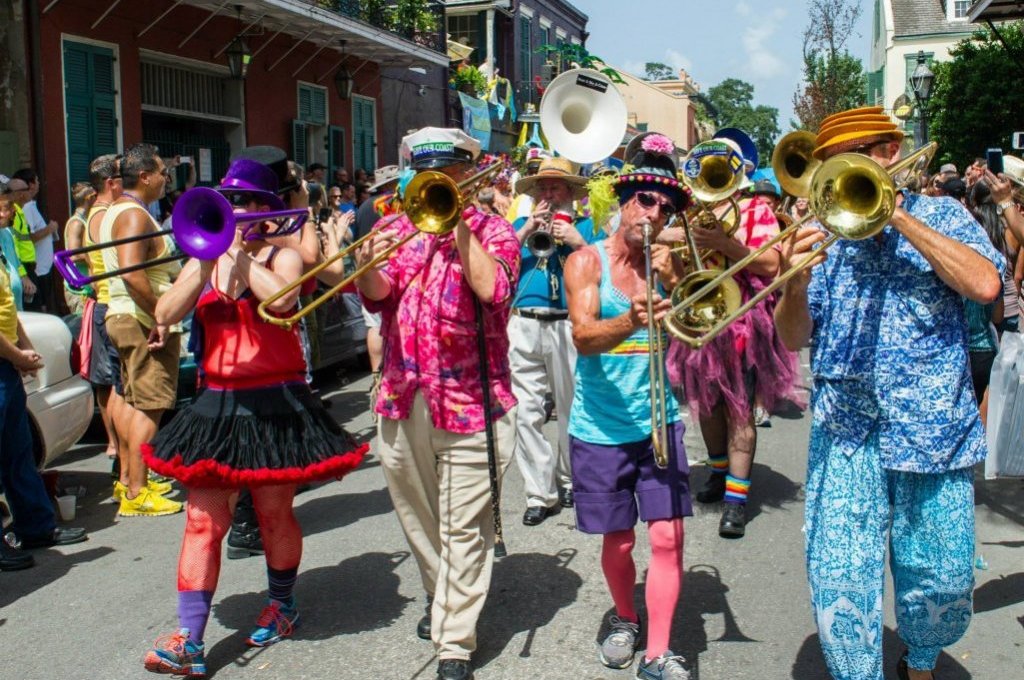
When September hits in New Orleans, it doesn’t mean summer has given up the ghost, even if everyone is back in school. As far as festivals and events go, New Orleans doesn’t slow down in this regard either. Here are some of the happenings hitting the Crescent City and the area around the French Quarter as we enter September.
Southern Decadence
August 29 – September 1, 2025
If you’re in town over the Labor Day weekend, check out Southern Decadence. This popular festival celebrates LGBTQ+ culture and attracts participants from all over the world. What started as a simple going-away party in the 1970s is now considered the fifth largest event in the city after Mardi Gras, Jazz Fest, Essence Festival, and the French Quarter Festival.
The festival’s annual hub, Bourbon Pub Parade, will be open till 5 a.m. on Friday and Saturday. Just like in previous years, it will serve as an epicenter of the Bourbon Street Extravaganza, a free show/block party happening on Saturday at the corner of Bourbon and St. Ann Streets. The annual Southern Decadence Grand Marshal Parade on Sunday will also end up there. For the event’s schedule, check out its website.
NOLAXNOLA
September 25-October 5, 2025
So, what is NOLAxNOLA exactly? Pronounced “NOLA by NOLA,” it’s a celebration of New Orleans music, venues and artists. In 2021, a coalition of New Orleans artists, venues and cultural leaders banded together to support one another and keep the music community and culture bearers strong in those difficult times. The event featured a huge and impressive case of New Orleans artists and was a success, so it came back in 2022 with even more shows and more venues participating.
Supposed to be even bigger this year, NOLAXNOLA is not to be missed. For this year’s artist roster and participating venues list, check out the event’s website.
Need somewhere to stay during your fall visit to New Orleans? Be sure to check out our resource for French Quarter Hotels!
Related Articles
JOIN THE NEWSLETTER!
White Linen Night
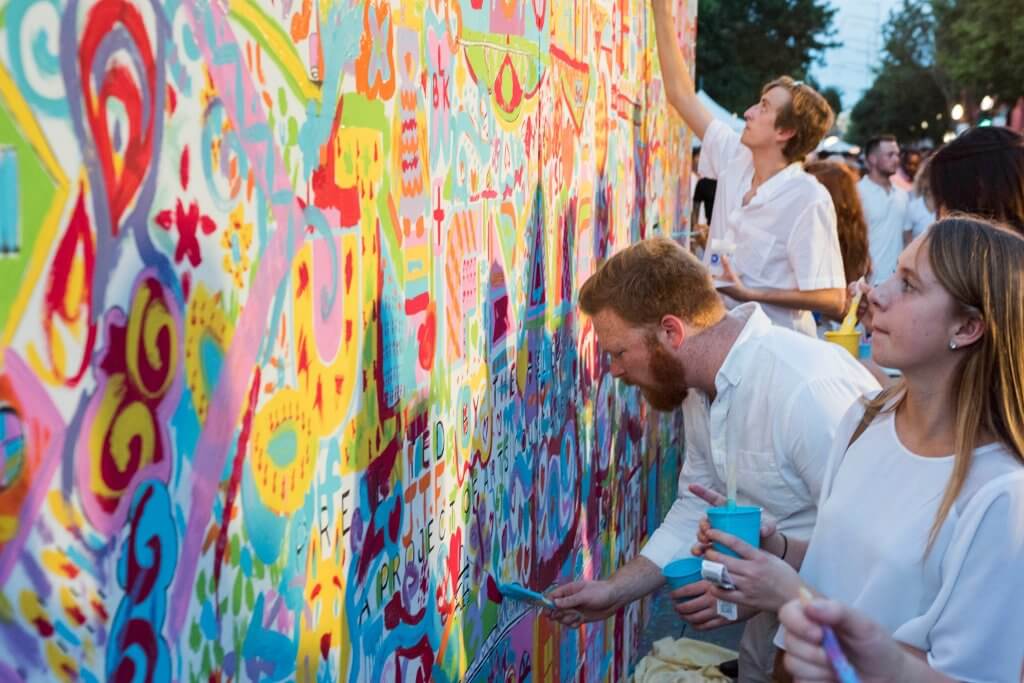
Photo courtesy of Contemporary Arts Center New Orleans on Facebook
Back in the days before air conditioning, New Orleanians kept cool and looked fresh in the face of August swelter by wearing light-colored linen clothing. Back in the days before White Linen Night, local art galleries felt the pinch of the August tourism slowdown.
In order to combat said slowdown, and to showcase local summer fashion, White Linen Night was created (Fidelity Bank is the title sponsor). Art galleries and restaurants in the Arts/Warehouse District throw their doors open for a night of wine, art showcasing, dining, and more wine — plus modeling of, naturally, the latest in white-linen fashion.
The event, held on Saturday, August 2 this year from 5 to 10 p.m., has several components that showcase local art and provide plenty of opportunities to eat, dance, drink, and stroll in the New Orleans’ Arts District in Central Business District (CBD). One of the main features is a free block party and an open house for galleries on the 300-600 blocks of Julia Street in the Arts/Warehouse District, with live music and dozens of food and drink stands.
The events also spill out onto neighboring streets throughout the area, including Magazine and Camp streets. In addition to most galleries on Julia Street, the Contemporary Arts Center (CAC) and the Ogden Museum of Southern Art will be open. As the name suggests, participants are invited to wear white.
You can check out this guide to see which galleries are participating. Remember, the block party is free, though you’ll have to get tickets to buy food and drinks. There’s also a ticketed “cool down lounge” on-site.
The event is usually really well attended, so parking is limited, though there’s some street parking as well as the paid parking lots in the area.
So, don your best white linen and brave the heat to support the Arts District New Orleans as they celebrate 31 years of this unique event!
Related Articles
JOIN THE NEWSLETTER!
The Rundown of the Running of the Bulls in New Orleans
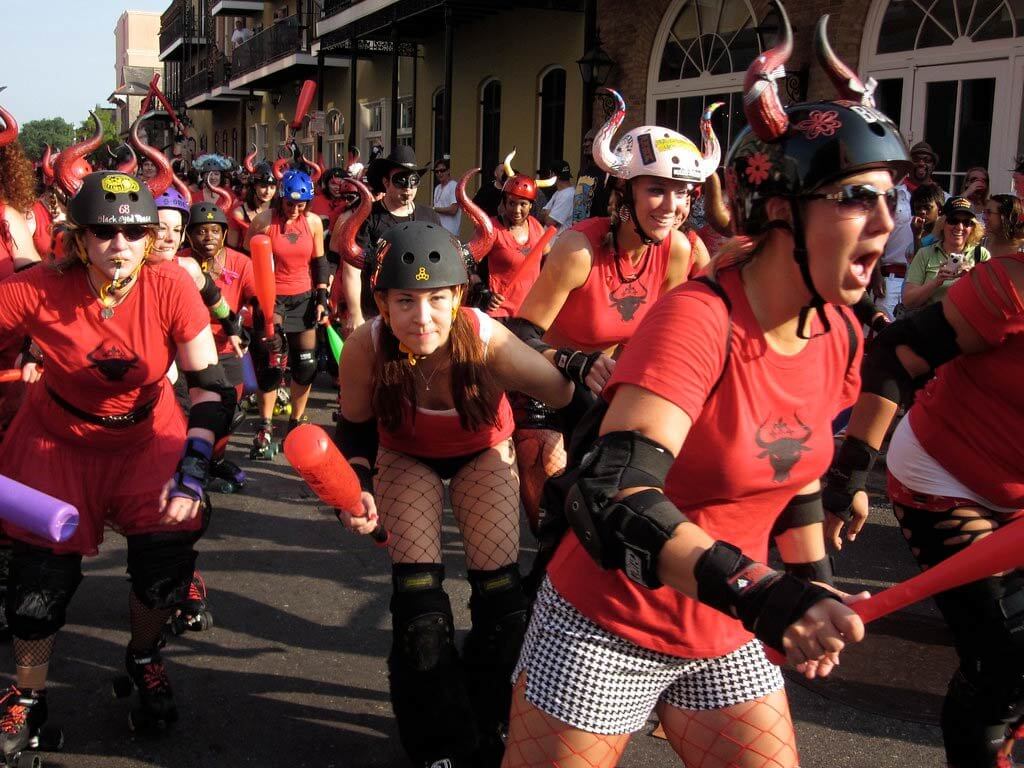
Photo: Some rights reserved by Infrogmation
Most people are familiar with Spain’s Encierro de Pamplona, but not everyone might realize that New Orleans hosts its own Running of the Bulls. Here, though, the “bulls” are the roller derby skaters, dressed in the traditional colors of Spain’s bull run and wearing horned helmets, who whack the participants with plastic bats during this annual Encierro (bull run).
The 19th annual summer spectacle falls on July 11-13 this year. Here’s the daily rundown.
Friday, July 11, 2025
Friday evening marks the opening of SFNO, called El Txupinazo (pronounced “ el choo-pin-AHT-so”). One of the charities that benefit from this festival, Beth’s Friends Forever, will host this event at the event’s new venue this year, High Grinds Coffee (1724 St. Charles Ave.), 6-9 p.m. Expect live music, an open bar, a silent auction, and a live auction for a lifetime VIP package for SFNO. This year, the food and the drinks will be provided by Atchafalaya, High Grinds, Juan’s Flying Burrito, and Sidecar Nola.
Saturday, July 11, 2025
The actual Encierro will be held on Saturday. Join thousands of runners, wearing all white and accessorized with red scarves and handkerchiefs, as they gather by 6:30 a.m. at Gallier Hall in downtown New Orleans (545 St. Charles Ave). Yes, the party starts early, and there will be live music, beer, sangria, and food trucks on-site to get things going.
The Procession of San Fermin and an invocation kick off the morning, followed by the run, which starts at 8 a.m. sharp. The run lasts till about noon. After that, you can attend the traditional La Fiesta de Pantalones, held at Espiritu Mezcaleria (520 Capdeville St.) starting at noon, or join the other revelers who stick around to make a day of it bar-crawling downtown, including the Warehouse District.
Sunday, July 13, 2025
Close out with the annual El Pobre de Mí (“Poor Me”) burlesque brunch at Gallier Hall, 11:30 a.m. – 2:30 p.m. This is a ticketed event, and there will be a cash bar and food on site.
What else to know
- All events are ticketed — proceeds go to charity (register and get tickets online).
- SFNO benefits Beth’s Friends Forever (named after NOLA Bulls cofounder Beth Hanning), which raises money for financially needy women fighting cancer in the Greater New Orleans area.
- Since drinking is part of the festival, prepare to get carded.
- El Txupinazo on Friday is 18+ only.
- While there is no dress code, the event organizers encourage everyone to dress in the style of Spain’s Encierro de Pamplona: white top and bottom, with something red around the waist and the neck. This being New Orleans, many runners do, and get very creative with their gear.
- There are several paid parking lots in the area, but this is a popular event, so it will most likely be crowded, with limited parking options all around.
- No outside food and drinks are allowed inside Gallier Hall on the day of the run, and no ice chests or chairs.
- Review the rules of the run before you take off, like no touching the bulls and placing kids under 10 on the sidewalk.
Coming to New Orleans this Summer?
Check out our guide to where to stay in the French Quarter, and be sure to check out our resource for French Quarter Hotels. Also, consider booking a guided tour of St. Louis Cemetery No. 1 to experience the hauntingly beautiful past of New Orleans.
For easy, informative sightseeing, we recommend the City Sightseeing New Orleans city tour on the open-top, double-decker bus. It runs every 30 minutes through the Garden District, French Quarter, and CBD. You can hop on and off anytime!
Related Articles
JOIN THE NEWSLETTER!
Satchmo SummerFest Celebrates the Legacy of Louis Armstrong
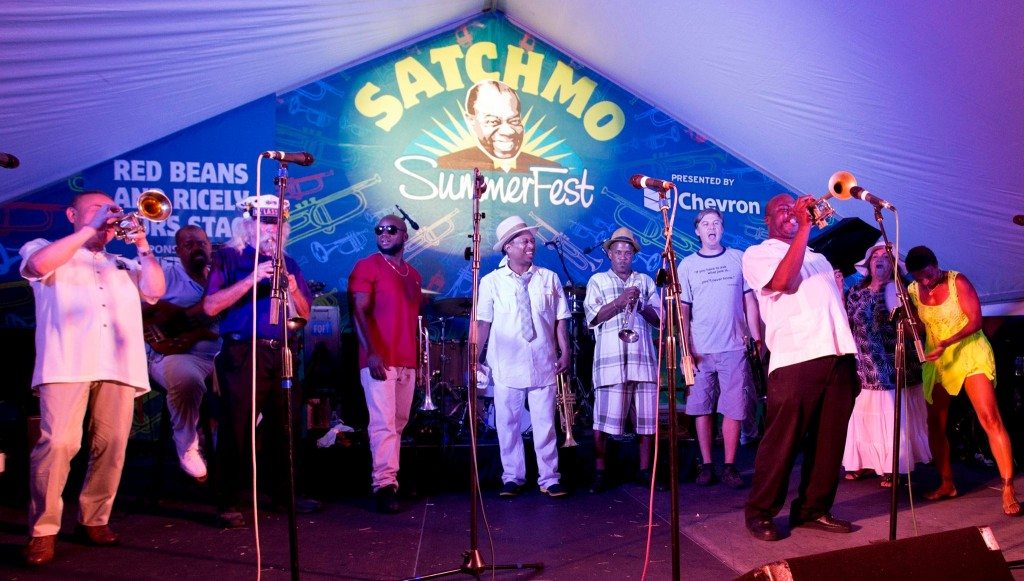
Photo courtesy of Satchmo SummerFest on Facebook
Satchmo SummerFest started in 2001 as a tribute to Louis Armstrong, one of New Orleans’ most prominent native residents, on his 100th birthday (“Satchmo” was one of Armstrong’s several nicknames). Ever since, the fest remains the August highlight and just the respite we need from the long weeks of summer.
The annual festival, traditionally held over the first weekend of August in the French Quarter (falling on Saturday, August 2, and Sunday, August 3, 2025, this year), is easy to navigate and get to. The fest will be spread on two stages at the New Orleans Jazz Museum (at the Old U.S. Mint).
While the 2025 music and vendor lineups are TBA, the always-stellar music lineup included in the past the Big 6 Brass Band, Treme Brass Band, Preservation Brass, Jeremy Davenport, Charmaine Neville, The Original Pinettes Brass Band, and more.
Among the festival’s traditional special events, the annual Jazz Mass will again be held at St. Augustine church (1210 Governor Nicholls St.) on Sunday, August 4, at 10 a.m. It’s a popular event, so arrive early if you plan to attend.
Immediately following mass, join the “Satchmo Salute” second line parade, which will make its way from the church to Armstrong Park before secondlining down to Esplanade Avenue and the festival’s grounds at the New Orleans Jazz Museum.
For schedule, lineup and updates please check the event’s website or its Facebook page.
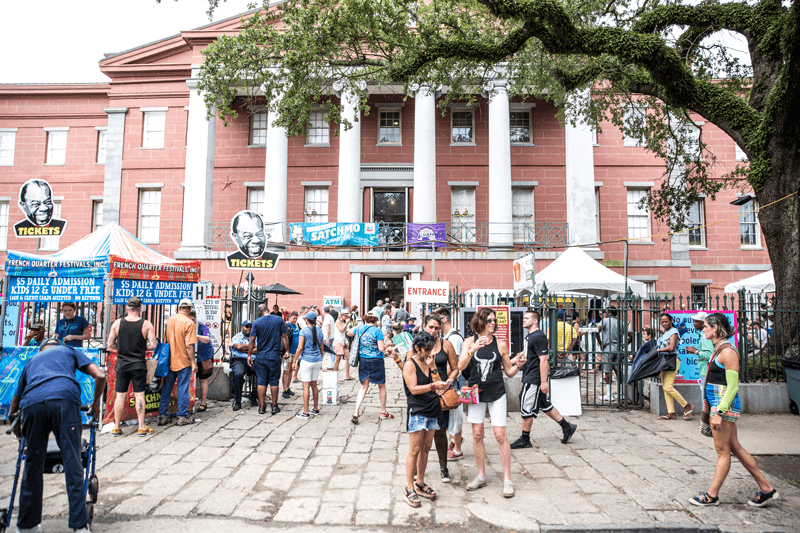
Photo courtesy of Satchmo SummerFest on Facebook
You may also want to know:
Admission is free.
There will be shaded picnic tables on the grounds for dining.
Parking: For street parking, you may want to look along the stretch of the French Market and at the foot of Esplanade Avenue. There is also a 24/7 parking lot by the French Market along the river. Enter from St. Peter Street.
Pops’ Playhouse for Kids at the Jazz Museum will have children’s activities.
No coolers or ice chests, and no outside food or drink, please.
Festival details:
What: The annual Satchmo SummerFest
When: Saturday-Sunday, August 2-3, 2025
Where: New Orleans Jazz Museum (at the U.S. Mint, 400 Esplanade Ave., French Quarter)
Admission: Free
Schedule and food vendors: https://satchmosummerfest.org/
Coming to New Orleans in August?
Check out our guide to where to stay in the French Quarter, and be sure to check out our resource for French Quarter Hotels. Also, consider booking a guided tour of St. Louis Cemetery No. 1 to experience the hauntingly beautiful past of New Orleans.
For easy, informative sightseeing, we recommend the City Sightseeing New Orleans city tour on the open-top, double-decker bus. It runs every 30 minutes through the Garden District, French Quarter, and CBD. You can hop on and off anytime!
Happy August!


